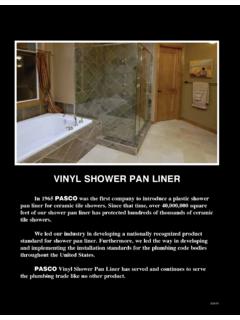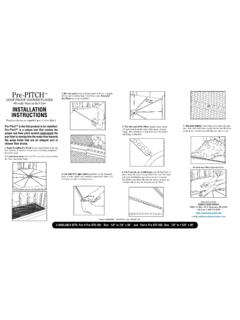Transcription of The Kerdi Shower Book
1 The Kerdi Shower BookJohn P. BridgeHoustonIntroduction ..1 Chapter One: Framing and General Construction ..4 Corners ..6 Door Openings ..7 Benches (Seats) ..8 Curbs/Dams/Hobs (wood subfloors) ..9 Curbs/Dams/Hobs (concrete subfloors) ..10 Niches ..11 Grab Bar Backing ..13 Chapter Two: Drywall ..14 Pipe and Wire Protection ..14 Walls ..15 Shower Valves ..16 Knee Walls ..17 Curbs ..17 Taping and Finishing ..18 Cement Backer Board ..18 Masonry and Concrete Walls ..19 Shower Floors ..19 Kerdi - Shower ST ..19 Mud Shower Floor ..21 Curbed Shower ..24 Chapter Three: Waterproofing with Kerdi ..26 Thin set Mortar ..26 Cutting Kerdi ..27 Installing Kerdi ..28 Window Waterproofing ..30 Tub Surrounds ..31 Waterproofing Niches ..32 Seats/Benches (straight) ..34 Seat/Benches (curved) ..36 Other Benches ..43 Foot Rests ..44 Curb Attachment ..45 Neo-angle Curbs ..47 Floor Membrane Attachment.
2 47 Doing the Floor Later ..53 Quality Brewskies ..55 Chapter Four: Tiling the Shower ..56 Tile Removal ..56 Tiling a Corner Seat ..57 Tiling Niches ..58 Tiling Shower Curbs ..60 Making Full-Width Bullnose (Double Bullnose) ..61 Tiling Knee Walls ..63 Installing Shower Floor Tiles ..64 Grouting and Finishing Up ..67 Sealers ..68 Maintenance ..69 ContentsTH E KE R D I SH O W E R BO O K 4 Chapter One: Framing and General ConstructionTraditional Shower building in the United States, Canada and in other countries has for decades been based on the premise that tile showers ultimately leak. Although certain tiles are waterproof, most are not, and cement grout is not, either. Additionally, grout develops cracks from time to time, and water enters in surprising amounts when this is particularly apparent in the floor and lower wall areas of the Shower , and for this reason a Shower pan is incorporated into a traditional Shower s design.
3 Shower pans are constructed from flexible waterproof materials that can be bent and folded into the base of the Shower . The lining material, which might be PVC, CPE, copper, lead or hot mopped roofing, is installed under the mortar and tiles that comprise the Shower floor. The material extends upward against the walls to a point that is about 3 inches above the rough A preslope of cement mortar is installed under the liner to direct water toward a central drain to which the liner material is attached. Water thus collected drains through weep holes in the base of the drain. All of this occurs under the tile and mortar. You can t see it happening. (Figure 1)Although the traditional tiled Shower disposes of waste water somewhat efficiently, it s very possible (and in fact, probable) that all of the water will not drain from the base of the Shower between uses.
4 Once commissioned, the Shower floor will remain wet, storing water continuously as long as the Shower is used on a routine basis. The presence of water in the Shower floor contributes to the growth of black mold on the surface of the grout joints, since the grout never truly dries out. Also, other forms of microscopic life can thrive within the installation due to the water s presence. And if for some reason the Shower has not been constructed correctly, or if 1 The Shower curb can also be called a dam, a step and in certain countries, a hob. TH E KE R D I SH O W E R BO O K 5the drain weep holes have somehow become blocked, copious amounts of water will collect in the liner . This ultimately leads to wicking in the lower wall substrates. Water is drawn upward higher and higher depending on how often the Shower is used. Eventually, this water finds its way into wall cavities where it is stored in wood framing members, insulation and wall sheathing.
5 It s a mess, pure and simple. (Figure 2)Wouldn t it be better if someone were to come up with a system whereby water never has a chance to enter the substrates at the floor and walls? Wouldn t it be great to have a waterproof Shower that dries out completely between uses, one in which mold never has a chance to take root?That is precisely what the Kerdi system provides. The Kerdi membrane, instead of being embedded under the Shower floor mortar, resides on its surface just under the tile layer. Water cannot possibly invade the lower regions of the floor. Additionally, this membrane is not limited to the lower wall and floor area. Instead, it goes all the way up to the height of the Shower head. All surfaces below a height of approximately six feet walls, ledges, niches and benches Figure 2. No waterproofing was used in this 1. The Shower pan is below the E KE R D I SH O W E R BO O K 6included are thus totally protected.
6 Water cannot go beyond the grout joints, and what moisture does enter will easily evaporate between Shower uses. I m telling you, this is exciting about as exiting as it gets in my business. Can you feel it?DAlthough Kerdi showers can most certainly be constructed over masonry walls, the bulk of them will incorporate wood or metal framing systems, and that s how we shall approach the task. I ll mention masonry walls a little further along and explain the differences you can again, we won t be doing a thorough job of instructing here. I will instead cover some of the incidental, perhaps uncommon and problematic, items that might be encountered in the course of providing an adequate skeleton for your Shower . I am assuming you are an advanced weekend warrior in the sense that you are familiar with framing terms and components. If that is not the case, you have some research to do employing other many remodeling situations the Shower will have been previously framed, and you ll simply be replacing one tile installation with another.
7 And in that case you will be more or less improving and reinforcing what wood framing is already there. Making the various components of the skeleton as strong as possible goes a long way toward creating a finished product that is indestructible or nearly well-constructed wood frame homes the intersections of walls are composed of several vertical framing members (studs), all fastened securely to one another. Unfortunately, all houses are not well constructed, and efforts should be made to ensure that your corners are stiff and strong. I suggest you use screws instead of nails for all framing work that you might do in and around your Shower . Screws draw members together. Nails simply hold things in there are only blocks or segments of wood in your corner posts, make the best of them by screwing the studs on both sides to the blocks. If there is room to add more backing, by all means, do so.
8 Solid members are always better than segmented ones. Use drywall screws or deck screws that are about 2-1/2-inches long to attach framing members to one another. And don t be skimpy in the use of screws. They are cheap insurance in the big scheme of things. (Figure 3)Since Kerdi showers are composed largely of wallboard (drywall/plasterboard), stiffening the corners and intersections will improve the continuity of the Shower . Everything moves to TH E KE R D I SH O W E R BO O K 7some extent in a frame structure. It s your job to make sure it moves as little as OpeningsIf your Shower is to have walls alongside the door opening (jamb returns), it s important to make sure they are strong and stiff enough to support a swinging Shower door. This is true whether you intend to use a door or a curtain. Someone down the road may decide to install a glass door where only a Shower curtain hung before.
9 Vertical framing members or studs should be doubled at all openings, and the studs should be screwed tightly to one another. Where single studs must be used for one reason or another, connect them to the next stud over with horizontal wood blocks. This will provide some stiffness, and it s easy to do. (Figure 4)If your Shower will not have jamb returns, you must pay particular attention to strengthening the ends of walls where Shower doors will most likely be attached. This is especially important now that frameless glass enclosures have become popular. These enclosures incorporate very heavy plate glass, and it is necessary that hinge points be backed with solid (Seats)Benches in showers can be built by several methods, to include wood framing. It goes without saying that the bench must be sturdy. The front and sides of the bench should be built the same way larger walls are Figure 3.
10 Corner studs are screwed 4. Studs installed sidewise to gain space in E KE R D I SH O W E R BO O K 8built. Horizontal framing members or plates should be used top and bottom with short vertical studs supporting them. The wall sections must be screwed tightly together, and the entire structure must be secured to the Shower walls and floor. Don t leave anything to chance. If you are uncertain whether you have used enough lumber, use a little more. No one will fault you for building the seat stronger than needed. (Figure 5) Horizontal surfaces in a Shower are never actually horizontal or level; they are instead tilted slightly in the direction of the Shower drain so that excessive amounts of water will not collect on them. And so it will be necessary for you to build your seat with a sloped top. Shower seats, in order to function comfortably, need to be a minimum of 14 inches from the front to the wall.





